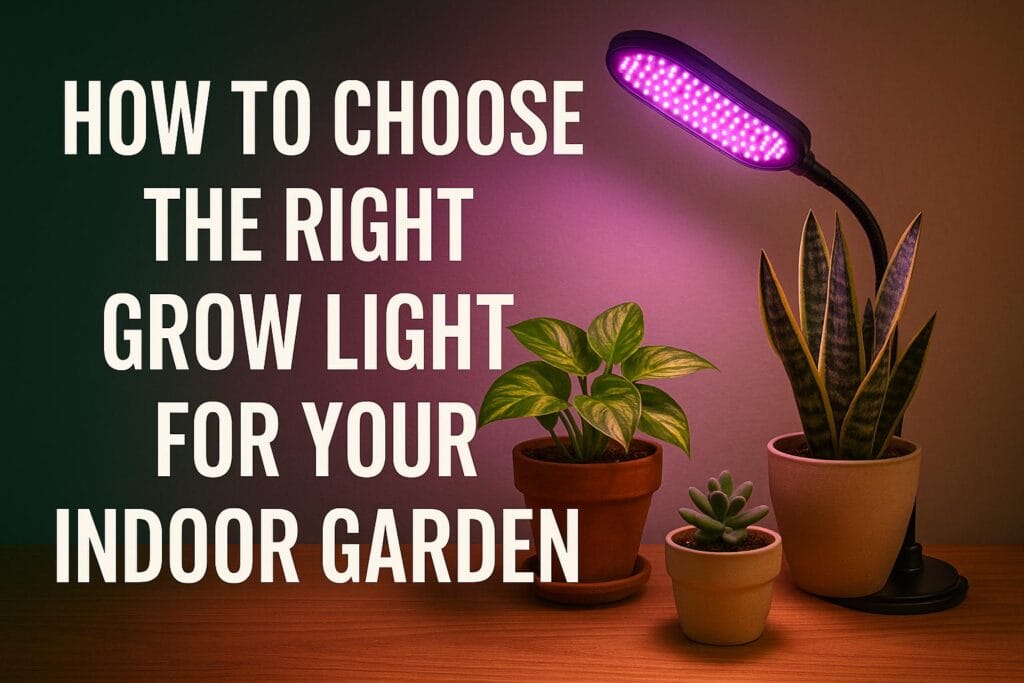How to Choose the Right Grow Light for Your Indoor Garden: A Complete Guide
Introduction
Indoor gardening is booming across the U.S., especially in apartments and homes where outdoor space is limited. But there’s one crucial element often overlooked—light. Not all homes get enough natural sunlight, and that’s where grow lights come in.
Whether you’re growing herbs on your kitchen shelf or maintaining a full-fledged houseplant jungle, the right grow light can boost plant health, speed up growth, and enhance indoor décor.
So, how do you choose the right one? Let’s dig in!
Why You Need Grow Lights for Indoor Plants
Natural sunlight contains a full spectrum of light essential for photosynthesis. But inside your home, that full spectrum is often lacking—especially in winter or in rooms without direct sun.
Grow lights mimic natural sunlight, providing your plants with the spectrum they need to thrive.
Benefits of Using Grow Lights:
- Boosts plant growth during low-light seasons
- Helps seedlings develop strong roots
- Encourages flowering and fruiting
- Allows gardening in rooms with zero sunlight
Types of Grow Lights (With Pros & Cons)
Not all grow lights are created equal. Here’s a breakdown of the 4 main types:
1. Fluorescent Grow Lights (CFL & T5)
Great for beginners and small spaces.
Pros:
- Energy-efficient
- Affordable
- Cool-running (less risk of burning plants)
Cons:
- Less intense light
- Bulky for larger setups
Best for: Herbs, leafy greens, seedlings
2. LED Grow Lights
Most popular in 2025 due to technology and efficiency.
Pros:
- Full-spectrum options available
- Long lifespan (up to 50,000 hours)
- Low heat output
- Compact & stylish designs
Cons:
- Higher upfront cost
Best for: Most indoor plants, including flowering and fruiting varieties
3. Incandescent Grow Lights
Older option—mostly phased out.
Pros:
- Cheap and widely available
Cons:
- High energy consumption
- Heats up quickly
- Poor spectrum for plant growth
Best for: Not recommended today
4. HID Lights (High-Intensity Discharge)
Used in professional indoor gardens.
Pros:
- Extremely powerful
- Great for high-light plants like tomatoes or cannabis
Cons:
- Expensive setup
Runs hot, needs ventilation
Best for: Commercial or advanced hobbyist use
Full-Spectrum vs. Specific Spectrum: What Do Plants Need?
Plants primarily use blue and red wavelengths for photosynthesis.
- Blue light (400–500 nm): Promotes leafy growth
- Red light (600–700 nm): Helps with flowering and fruiting
- Full-spectrum grow lights: Mimic natural sunlight and cover all plant stages
For beginners, a full-spectrum LED is the safest and most versatile choice.
How to Choose the Right Grow Light: Step-by-Step
1. Know Your Plant’s Light Requirements
Plants are typically classified into:
- Low light (e.g., snake plant, pothos)
- Medium light (e.g., peace lily, spider plant)
- High light (e.g., succulents, citrus trees)
Match your grow light intensity to the plant type.
2. Measure Light Intensity (PPFD)
Look for PPFD (Photosynthetic Photon Flux Density) in specs—it tells you how much usable light reaches the plant.
Aim for:
- 100–300 µmol/m²/s for low-light plants
- 300–600 µmol/m²/s for medium-light plants
- 600–900+ µmol/m²/s for high-light or flowering plants
3. Check Wattage and Coverage Area
Don’t just go by watts—check how much area the light covers effectively.
Example:
- 20W LED panel → good for 1–2 small plants
- 100W full-spectrum → good for a 2×2 ft area
4. Adjustable Height and Timer Function
Choose a light that lets you:
- Adjust height as plants grow
- Use built-in timers for 12–16 hours/day cycles
This saves energy and prevents overexposure.
5. Energy Efficiency and Lifespan
Choose models with:
- Energy Star ratings
- Lifespan of 30,000–50,000 hours
LEDs beat all other options here.
6. Budget and Aesthetic
If your grow light is going in a living room, look for sleek designs.
Budget options: $20–$50
Premium models: $100–$300 (longer lifespan, better spectrum)
Top 5 Grow Lights for Indoor Gardening (2025)
Here’s a quick list to help you start:
| Brand | Type | Best For |
| Spider Farmer SF-1000 | Full-Spectrum LED | Large setups |
| GE BR30 Grow Bulb | LED Bulb | Small spaces |
| Mars Hydro TS1000 | Full-Spectrum LED | Medium to large gardens |
| VIVOSUN T5 Fluorescent | Fluorescent | Seedlings, herbs |
| BLOOMSPECT 600W LED | Full-Spectrum LED | Budget option |
How Long Should You Run Grow Lights?
General rule: 12–16 hours/day, mimicking daylight.
- Seedlings: 16–18 hours
- Leafy greens: 12–14 hours
- Flowering/fruiting: up to 16 hours
Always allow 8 hours of darkness—plants need rest too!
Pro Tips for Maximizing Grow Light Efficiency
- Keep lights 12–24 inches from plant tops
- Rotate plants weekly for even light exposure
- Clean light covers monthly (dust reduces output!)
- Use reflective surfaces (foil, white walls)
FAQs – Grow Lights for Indoor Plants
1. Do all indoor plants need to grow lights?
Only if your space doesn’t get enough natural sunlight. Low-light plants may survive, but grow lights ensure healthy growth.
2. Can I use regular LED bulbs for plant growth?
Standard LEDs don’t have the full spectrum needed. Use only LEDs labeled as “grow lights.”
3. How many hours of light do indoor plants need?
Most plants need 12–16 hours of light daily and 8 hours of darkness.
4. Can I leave grow lights on 24/7?
No, overexposure can stress or kill the plant. Stick to natural daylight cycles.
5. What color light is best for plants?
Blue light for growth, red light for flowering. Full-spectrum lights provide both.
Conclusion
Choosing the right grow light isn’t just about wattage—it’s about understanding your plant’s needs, your room’s light conditions, and your gardening goals.
Whether you’re starting a herb garden in your kitchen or growing tropical plants in your living room, the right grow light can make all the difference.
